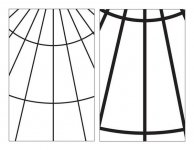Finder
Veteran
I have been having a very interesting conversation about mathematical perspective offline with one of our members since this thread began. And I think I have found the missing factor that people have been overlooking in this debate.
I was shown an image of my brick building with the crop superimposed over the original and showing they both share the same vanishing points. If both images share the same vanishing points, then both images have the same perspective.
But the illustration was not correct.
The comparison between the original and crop are done at the same size. The crop is enlarged to match the original. The change in magnification displaces the linear features so the two images do not share the same set of vanishing points anymore. And if two image have different vanishing points, they have different perspectives. Since the displacement would always be away from the original, perspective becomes weaker. This is also evident in the example illustrations I have been posting.
So cropping or changing focal length will be enough to change perspective.
I was shown an image of my brick building with the crop superimposed over the original and showing they both share the same vanishing points. If both images share the same vanishing points, then both images have the same perspective.
But the illustration was not correct.
The comparison between the original and crop are done at the same size. The crop is enlarged to match the original. The change in magnification displaces the linear features so the two images do not share the same set of vanishing points anymore. And if two image have different vanishing points, they have different perspectives. Since the displacement would always be away from the original, perspective becomes weaker. This is also evident in the example illustrations I have been posting.
So cropping or changing focal length will be enough to change perspective.
Attachments
Last edited:



